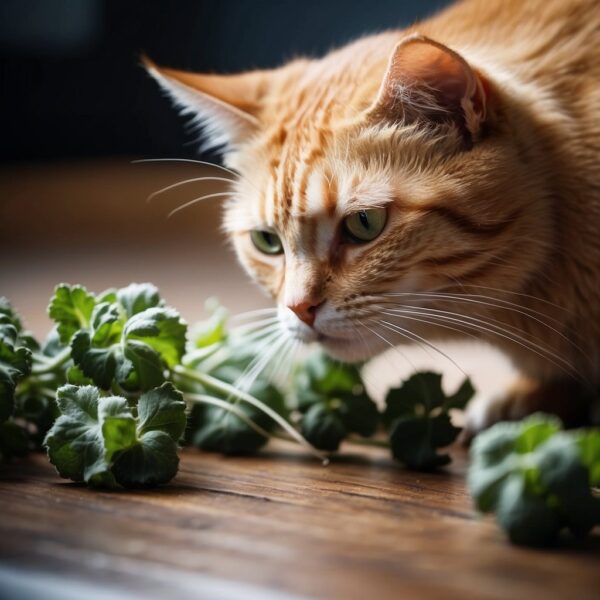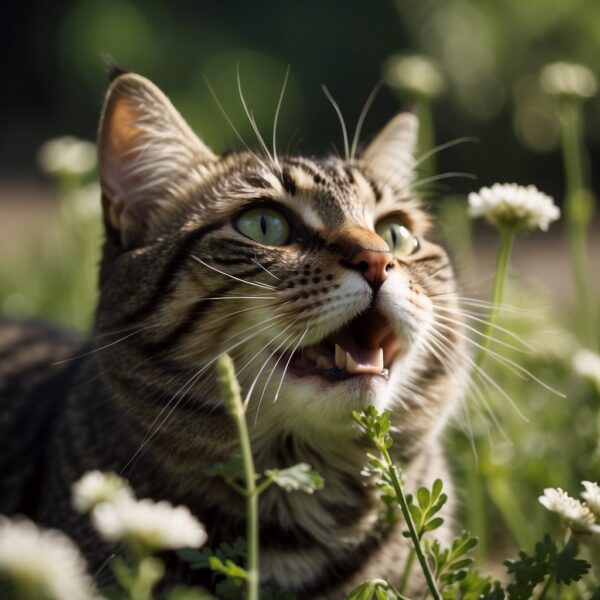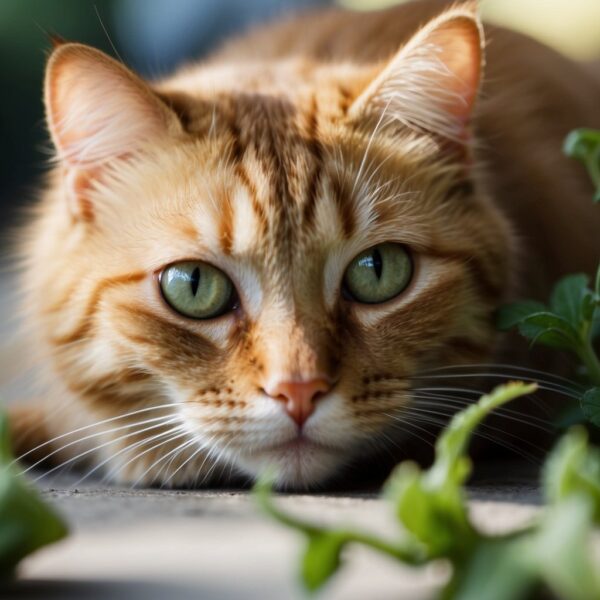
Cats and Catnip: The Feline Obsession
Many cat parents have witnessed the amusing and sometimes baffling behavior of their cats when exposed to catnip. Why do cats love catnip? This common herb elicits a range of responses in felines, from purring and rolling to hyperactivity and playfulness. The key compound responsible for this behavior is nepetalactone, an essential oil found in the leaves and stems of the catnip plant. This substance mimics feline pheromones and stimulates receptors in the cat’s brain, often resulting in a euphoric reaction.
While the majority of domestic cats are affected by catnip, not all cats respond to it. Sensitivity to catnip is hereditary, with an estimated two out of three cats being genetically predisposed to its effects. The evolutionary advantage of this sensitivity remains a subject of research, but it may be associated with the plant’s natural insect repellent properties, which could have benefited cats in the wild. Although catnip primarily affects domestic cats, it’s interesting to note that certain other species in the feline family also react to the plant.
Key Takeaways Why Cats Love Catnip
- Catnip triggers a euphoric response in many cats due to the compound nepetalactone.
- Genetic factors determine a cat’s sensitivity to catnip.
- The effects of catnip, while predominantly observed in domestic cats, can affect other feline species.
Why Cats Love Catnip: Chemical Compounds in Catnip
Catnip’s allure for felines is primarily due to a single compound found within the plant.
why cats love catnip: Nepetalactone and Its Effects
Nepetalactone is the volatile oil found in the leaves, stems, and flowers of the Nepeta cataria plant, commonly known as catnip. This compound binds to the olfactory receptors in cats, typically leading to a temporary state of euphoria. Affected cats may exhibit behaviors such as:
- Rubbing against the source of nepetalactone
- Rolling on the ground
- Purring
- Hyperactivity
The effect of nepetalactone is short-lived, generally lasting between 5 to 15 minutes. Following exposure, cats usually experience a period of about 30 minutes during which they are temporarily immune to the compound’s effects. Not all cats are affected by nepetalactone; susceptibility is hereditary, with an estimated 70 to 80 percent of cats responding to the compound.

cats and catnip: Behavioral Responses
Catnip elicits a spectrum of behavioral responses among felines, attributed to the compound nepetalactone. This explains why cats love cantip.
Common Reactions to Catnip
When exposed to catnip, cats may display behaviors such as:
- Rubbing: They typically rub their faces and bodies against the source of catnip.
- Rolling: Cats commonly roll over the floor in response to the stimuli.
- Chewing: They may chew on the plant to release more nepetalactone.
- Licking: Licking is another frequent reaction to coming into contact with catnip.
- Leaping: Some cats get extremely playful and may start leaping around.
- Vocalizing: Meowing or purring may increase during exposure.
These behaviors are believed to mimic feline natural pheromones, thereby causing pleasure or excitement and why cats love catnip.
Variation Among Individual Cats
The reaction to catnip can vary due to different factors:
- Genetics: Approximately 70-80% of cats are influenced by catnip, indicating a hereditary component.
- Age: Kittens under six months old typically do not respond to catnip.
The strength of the response can differ widely, with some cats love catnip, showing intense activity, while others remain indifferent.

Genetic Factors Influencing Catnip Sensitivity
Cats’ varied reactions to catnip are largely determined by genetic factors. Specifically, the hereditary aspect dictates sensitivity to the compound nepetalactone, found in catnip.
Hereditary Response to Nepetalactone
Nepetalactone is the essential oil in catnip that triggers a response in cats. Scientific studies have determined that a genetic predisposition is responsible for how cats react to this compound. Approximately 50-70% of cats are affected by catnip, indicating that this trait is not universal among all cats.
Cats inherit a sensitivity to nepetalactone, and this hereditary trait varies widely. Kittens under the age of six months generally do not exhibit any reaction to catnip, which suggests the presence and developmental stage of specific receptors in their brains are critical. A cat’s genetic makeup either endows it with these receptors or not, which accounts for the binary nature of the catnip response: some cats experience a noticeable euphoria and love catnip, while others remain indifferent.
Another point of interest is the potential development of tolerance or immunity over time. Just as with other genetic traits, mutation and natural selection play roles in how genes related to catnip sensitivity are passed down and expressed in feline populations. The genetic factors influencing a cat’s reaction to catnip are not solely based on the presence of a single gene but may instead be part of a more complex genetic system.

Evolutionary Perspective
The affinity cats have for catnip is more than a mere coincidence; it’s a result of complex evolutionary processes.
Evolutionary Advantages for Cats
Natural Attractant: Cats are instinctively drawn to catnip due to nepetalactone, a compound that mimics the pheromones that affect feline behavior. This attraction may have evolved as a way for cats to identify and locate a beneficial plant in their environment.
- Chemical Communication: Nepetalactone likely plays a role in how cats communicate through scent. This compound, by making catnip so enticing, facilitates a form of environmental enrichment, enhancing a cat’s interaction with its surroundings through olfactory stimulation.
Recreational Behavior: The playful and euphoric reactions to catnip could provide cats with exercise and stress relief. Over time, those individuals who engaged with catnip may have gained advantages in fitness and survival, thus reinforcing the trait.
- Hunting Advantage: Engaging with catnip might simulate predatory habits, keeping a cat’s hunting instincts sharp, which could be beneficial for wild felines’ survival and hence would be a selected trait.
Insect Repellent: Research suggests that nepetalactone also acts as an insect repellent, providing potential health benefits by deterring parasites. Cats drawn to the plant could enjoy a secondary evolutionary benefit — protection from biting insects, which could reduce disease transmission.
- Self-Medication: There’s also speculation that exposure to catnip might aid in relieving discomfort or illness, though scientific evidence is needed. This behavior could suggest that an ancestral self-medicating trait has persisted in modern domestic cats.

Potential Benefits and Uses
Catnip, scientifically known as Nepeta cataria, holds the capability to both enrich a cat’s playtime and offer various health advantages due to its active compound, nepetalactone.
Catnip in Toys and Training
Incorporating catnip into toys can significantly enhance a cat’s interest in play, which can aid in keeping them engaged and physically active. This stimulation can be particularly beneficial for indoor cats, who may not get as much exercise as outdoor cats. Training efforts can also be supported by a cats’ love of catnip, using it as a reward or to encourage cats to use scratching posts and engage with other training tools.
Health Benefits of Catnip for Cats
Catnip has several health benefits for felines:
- Stress Reduction: Acts as a natural relaxant that can help reduce stress and anxiety in cats.
- Encourages Physical Activity: Can stimulate cats to play more, which promotes exercise and can prevent obesity.
- Digestive Aid: When ingested, catnip can serve as a mild herbal remedy for certain digestive issues like gas.
- Stimulant Effect: May invoke a euphoric state which is beneficial for indoor cats’ mental stimulation.
Catnip’s effects are temporary and usually last between 10 to 30 minutes, after which the cat becomes temporarily immune to its effects for a period before it can again trigger a response.
Responses in Other Species
While cats exhibit a unique affinity for catnip, it’s interesting to examine how other species react to this herb.
Reactions of Other Animals to Catnip
- Dogs: Generally indifferent to catnip, dogs do not seem to experience the same chemical attraction as cats.
- Rodents: Mice and rats may actually be repelled by catnip.
- Insects: Catnip has been found to be a potent insect repellent, especially for mosquitos and cockroaches.
- Humans: While not affected similarly to cats, some people use catnip in teas for its mild sedative properties.
- Birds: There is no significant evidence that catnip affects birds in any notable way.
- Livestock: Catnip does not typically elicit a behavioral response from livestock animals such as cows, pigs, and horses.
Why cats love catnip: Frequently Asked Questions
Catnip is well-known for its unique effect on feline behavior, evoking reactions ranging from playful zest to tranquil relaxation. Here we explore the most pertinent inquiries regarding catnip’s influence on cats.
What effects does catnip have on feline behavior?
When exposed to catnip, cats may exhibit behaviors such as rolling, flipping, rubbing, and eventual zoning out. Some cats become hyperactive while others may mellow down. This herb can impact cats both psychologically and physiologically.
Are there any risks associated with cats consuming too much catnip?
Consuming large amounts of catnip may lead to mild stomach upset in cats. However, it’s often self-limiting—cats usually stop when they’ve had enough. No severe toxicity is associated with catnip.
Why do cats exhibit increased playfulness with catnip?
Catnip contains nepetalactone, which acts on cats’ pheromone receptors and mimics the effects of natural cat pheromones. This typically results in a heightened state of playfulness and euphoria, akin to what felines experience during engaging activities, such as hunting.
What compounds in catnip cause cats to react?
The compound primarily responsible for the feline reaction to catnip is nepetalactone. It binds to the olfactory receptors in cats, which can trigger the behaviors commonly associated with catnip exposure.
Is the response to catnip universal among all cat species, including large cats?
Not all domestic cats react to catnip, and sensitivity is hereditary. About 50-70% of domestic cats are affected by it. Large cats, such as lions and leopards, may also respond to catnip, although individual reactions can vary.
How does catnip compare to stimulants that affect other species?
While catnip acts as a stimulant that can lead to temporary euphoria in cats, it is not similar to stimulants that affect other species. Stimulants that affect humans and other animals often work through different biochemical pathways and receptors.